Ok This might sound dumb but I am trying to get an equation for the radiation intensity of a pyramidal horn antenna in spherical coordinates. I got a whole bunch of books and they all have the same equation: $$ \mathbf{E}_\theta = \frac{j\, e^{-j k r}\, E_0\, A\, B\, (1 + \cos(\theta))\, \sin(\phi) ...}{8\, \lambda\, r} $$ $$ \mathbf{E}_\phi = \frac{j e^{-j k r} E_0\, A\, B\, (1 + \cos(\theta)) \cos(\phi) ...}{8\, \lambda\, r} $$
Ive got like 4 different text books about the subject and the all of them have those exact same equations. But not a single one says what \$r\$ is anywhere. Anybody know what this is?
Sorry to ask but I've been searching for hours. Can't find a single source that explicitly says what \$r\$ is.
